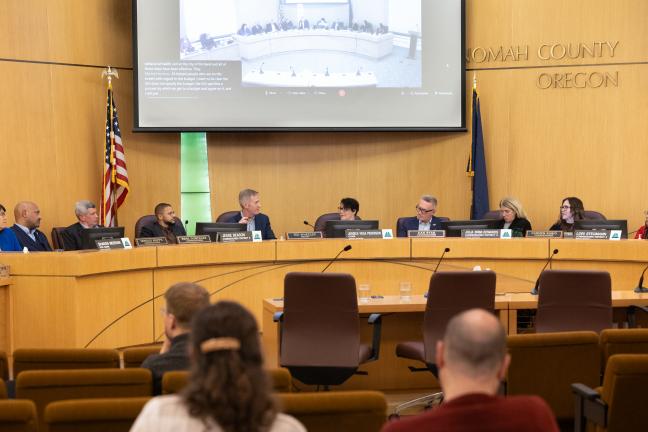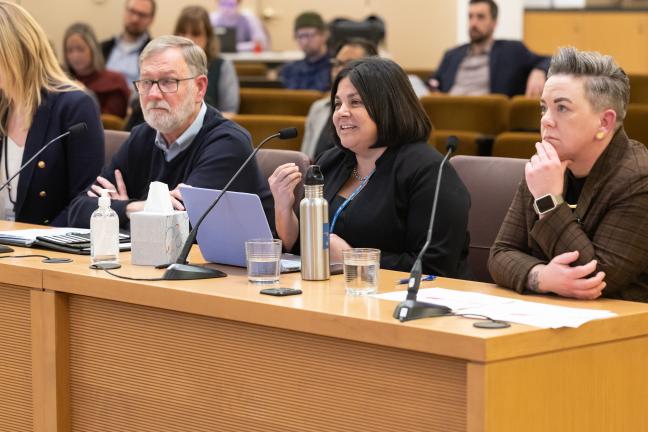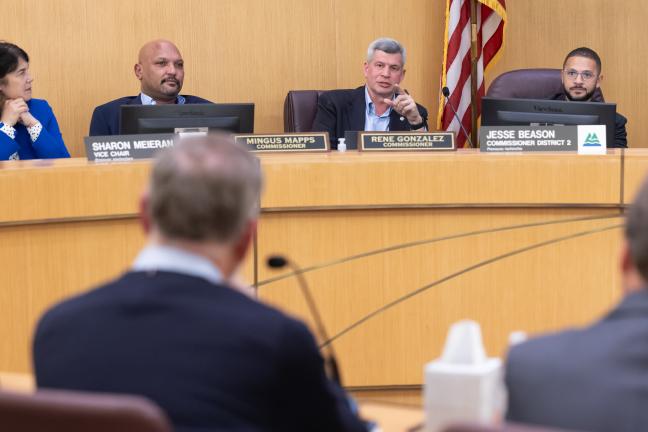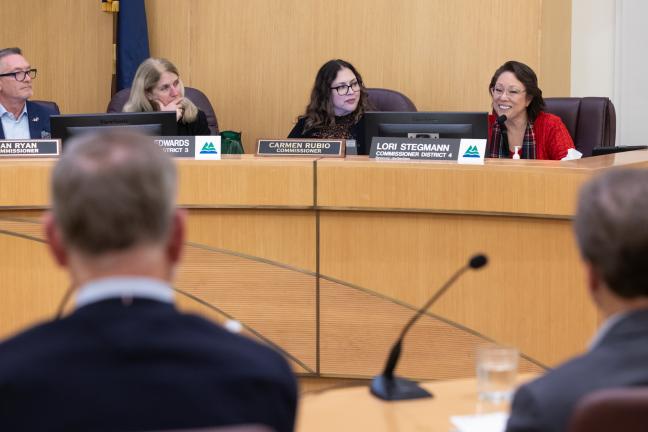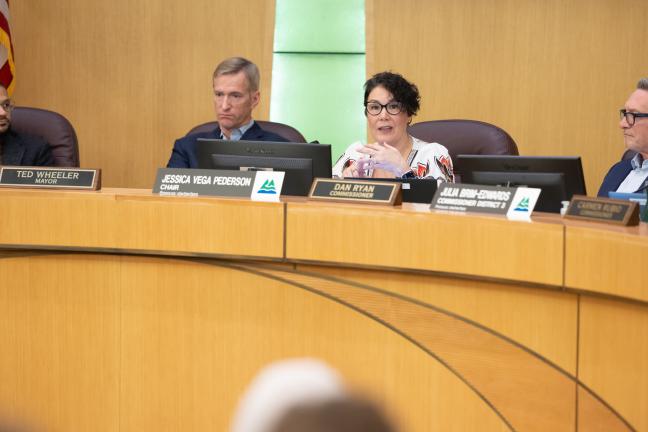On Thursday, Dec. 7, the Multnomah County Board of Commissioners and the Portland City Council met in a joint session for the second time this year to focus on their shared work addressing homelessness.
The leaders from both the City and County received updates on the past few months of work of the Joint Office of Homeless Services, including work to develop a community shelter strategy, and they discussed the previous day’s announcement by Chair Jessica Vega Pederson and Mayor Ted Wheeler outlining their shared vision for extending the life of the Joint Office.
The Chair and the Mayor on Thursday reiterated their shared commitment to working together and continuing to improve the City and County’s response to homelessness.“Our proposal turns the page on a relationship that has been fraught with misunderstanding and mistrust, and worst of all, a system that is not as effective as it can be,” Vega Pederson said. “And it moves us toward a genuine partnership built on collaboration and cooperation.”
“This is going to be hard, and there will be pitfalls along the way. But ultimately, we will be successful if we work together,” Wheeler said. “The revised agreements mark a new beginning and set the table for how the City of Portland and Multnomah County will work together to address homelessness.”
City and County share details on framework for intergovernmental agreement
City and County staff briefed the Board of Commissioners and City Council on the framework for their negotiations for extending their partnership in the Joint Office — building on the previous day’s announcement by Vega Pederson and Wheeler.
The full Council and Board will decide next year whether to approve a new intergovernmental agreement for the Joint Office once the current contract, which first took effect July 1, 2016, expires next summer.
“I am incredibly encouraged by the discussions at the table,” said Michael Jordan, Chief Administrative Officer for the City of Portland. “The people that are working on this issue are working really hard, in good faith, and I’m very encouraged that we’ll get to an agreement that we’ll all be proud of.”
Presenters went over the goals and metrics unveiled by Vega Pederson and Wheeler. Those include:
- Identifying a baseline number of people experiencing unsheltered homelessness as of January 2024, and working to rehouse or shelter a number of people equivalent to 50% of that baseline number by Dec. 31, 2025 — understanding that even as people move into shelter and housing, additional people will become homeless in that same span
- Achieving a 15% increase in people who leave shelter for housing by Dec. 31, 2025
- Ensuring at least 75% of people rehoused into permanent supportive housing retain their housing 24 months after placement
- Confirming that the City and County should continue approving their own portions of the Joint Office budget, but requiring more cross-jurisdictional staff collaboration in the development of the overall budget
- Requiring at least quarterly reports for the City and County on the goals in the agreement, and a public budget dashboard that shows budgeting and spending by program and revenue source for each fiscal year.
- Creating a “Homelessness Response System” governance model to jointly create goals, craft strategies and engage with the larger system of care
- Service expansion, including new projects and programs, will be led by the Joint Office; existing service programming shall be transferred under the Joint Office on the condition of continued progress toward outcomes
Beyond the shared goals around unsheltered homelessness overall, the recommendations proposed by the Mayor and Chair also call for higher rates of reductions among specific priority groups of people:
- Black/African American, or African
- Native Hawaiian or Other Pacific Islander
- American Indian, Alaskan Native, or Indigenous
- Latina/Latino/Latinx
- Asian, Asian American
- Adults over the age of 62
According to the framework, metrics and outcomes will be informed by the latest data from the Homeless Management Information System services database, including Built for Zero data, existing by-name lists, and all quality data sources.
The proposed new governance structure — called the “Homelessness Response System” — would consist of three committees: a Steering and Oversight Committee, an Implementation Committee, and a Community Advisory Committee.
Voting members on the Steering and Oversight Committee would include the Multnomah County Chair, the Portland Mayor, a designated County Commissioner, a designated City Commissioner, and a designated elected leader from an East County city.
The joint governance structure is in line with recommendations made by Health Management Associates, the third-party consulting firm contracted by the Joint Office to improve the effectiveness of the region’s homeless services. The County and City’s previous joint briefing, in September, focused on Health Management Associates’ findings.
“The work that it’s taken to develop the goals and direction, and then the structure that it will take to make this a reality — I think is what makes this effort different from the other times that we’ve tried,” said Serena Cruz, the County’s Chief Operating Officer. “This really is a system. To implement it, it will take coordination, the removal of barriers, constant communication, and the opportunity to turn that into a reality. It’s a little bit daunting, but it’s also very exciting.”
Joint Office shares progress on first quarter spending
City and County elected officials also heard updates on the finances of the Joint Office, specifically the office’s expenditures for the first four months of Fiscal Year 2023-24 (July 1 to Oct. 31, 2023).
Antoinette Payne, the department’s finance manager, said the Joint Office has so far spent $50 million of its $350 million operating budget, or 14%. That’s a faster spending pace than last year, when the office spent $35 million in its first quarter. The percentage might have been higher if not for the timing of two significant allocations of Supportive Housing Services Measure funds.
A large portion of those funds weren’t allocated until September, when the fiscal year was well under way.
The Board approved $62.5 million in unanticipated tax revenue and $17.6 million in unspent funds from the previous fiscal year. Payne said spending from other funding streams, including City and County general fund dollars, were on target.
Payne also said slower spending is traditional in the first quarter of the fiscal year, across all organizations. That’s when contracts are launched and programs ramp up. “We are expecting to trend toward increased spending in the coming months,” she said.
Joint Office shares sheltering strategy progress
Following up on the joint session in September, the Joint Office shared an update on one of the key recommendations shared by Health Management Associates — creating a shared sheltering strategy.
Anna Plumb, deputy director of the Joint Office, said the strategy is meant not only to identify goals and pathways for meeting the sheltering needs of the community, but also “to practice and demonstrate working together — working as a community to develop a community strategy.”
Plumb said the Joint Office, with guidance from Health Management Associates, quickly launched a steering committee and workgroup dedicated to the sheltering strategy. The steering committee, which meets twice a month, includes City Commissioners Carmen Rubio and Dan Ryan, and County Commissioners Lori Stegmann and Julia Brim-Edwards. The workgroup, which meets every week, includes Joint Office program and evaluation staff, representatives from service providers, and staff from Portland and Gresham.
Plumb said the groups will create strategies one “population system” at a time, focusing first on shelter for adults. Once that’s final, they will repeat the process for family shelters, youth shelters and shelters for domestic violence and sexual assault survivors.
Plumb said the groups are drafting ambitious but achievable shelter goals, and will be landing on specific goals in the next few weeks.
Tony Bernal, CEO of Transition Projects and one of the members of the workgroup, shared his appreciation for the work done so far.
“It seems like for the last several years, we have been going in different directions — City, County, providers — while unsheltered homelessness has been increasing rapidly,” Bernal said. “This particular process has been exactly what we needed. I think we’ve really seen some unprecedented collaboration, as we’ve come together to define some really measurable and achievable outcomes.”
Daniel Field, the director of the Joint Office, emphasized the rapid pace of progress. “The situation on our streets is urgent. So even as we move toward a governance model and a leadership model and finalize metrics that you all sign off on, we are not waiting. We are moving in that direction, and we are moving as quickly as the work will allow,” Field said.
Elected officials ask questions, share feedback
County Commissioner Sharon Meieran said she appreciated the work that’s been going into improving the City and County’s response to homelessness, but expressed frustration that it hadn’t happened sooner.
“We could have and should have been doing this for years,” she said. “It’s not like suddenly everything’s new and great and we’re starting afresh.”
City Commissioner Mingus Mapps, who oversees the Portland Bureau of Transportation (PBOT), said he’s been frustrated by how the City and County systems have felt disconnected in the past.
“One of my concerns here is I’m not sure if the City and County are trying to solve for the same problem,” Mapps said. “Every week, we clear about 70 camps. And every week, PBOT probably gets 15 derelict RVs off the road. Every time I make that intervention, the folks living in those camps or in those RVs need a place to go. And one of my frustrations with our current system is that is not automatically accounted for.”
City Commissioner Rene Gonzalez asked follow-up questions about how the City will guide financial decisions under the proposed framework, specifically whether it would guide only its direct investment in the Joint Office, which is about $41 million in FY 2023-24.
Field, the Joint Office director, said the goal is for the City not just to continue approving its own share of the Joint Office’s budget, but to help shape the Joint Office’s entire spending strategy.
“The goal really is to have aligned spending, and not just have the City exert control over the $41 million and have no say on the balance, which is a much larger number,” Field said. “The goal is for us to be aligned around the entire strategy, which reflects dollars coming in from the state, reflects dollars coming in from the federal government, and of course the big bucket of SHS dollars that are coming in.”
Gonzalez said he wants more clarity on the services the City funds through the Joint Office and how they intersect with existing City services.
“One of my critiques of this model is the City is writing a check for $41 million, but the City has substantial direct spend outside of that. Portland Street Response, CHAT, low-acuity medical — that’s just within the Portland Fire Department. Those are direct services, often, to the unsheltered population,” he said.
County Commissioner Jesse Beason said service providers should be involved in the implementation committee. As currently proposed, the committee does not include representatives from providers, who would instead be part of a Community Advisory Committee.
“When 80% of our dollars are going out to service providers, and we don’t actively engage them on the implementation side, I think we’re missing an opportunity to understand why we might not be meeting some of those outcomes,” Beason said.
Beason also said he hoped to see a change in the community’s conversation around homelessness.
“There’s a tenor right now in our community that seeks to scold before understanding. I think this IGA represents a shift in that,” he said.
City Commissioner Dan Ryan expressed support for the proposed framework, especially its focus on data. “It’s never been about anything other than getting to the truth,” he said.
Ryan also said that more work needs to be done to address the intersection of homelessness and behavioral health challenges, as well as ensure people who are in shelter are able to make progress toward recovery and housing. “What are we going to do that’s more courageous than we’ve done in the past, to work with our partners?” Ryan said. “And if we don’t want to do it, then we have to find new partners to go into this very challenging space.”
Field noted the Joint Office’s work to create metrics that measure the “throughput” of shelters — measuring where people go after shelter, and how successful they are in housing — and said the metrics would distinguish between different shelter types. Field said part of the goal of that will be measuring the success of different types of shelter, and holding providers accountable for a certain level of throughput.
County Commissioner Julia Brim-Edwards said she also supported the framework and goals, and public conversations like Thursday’s briefing. “The only way we’re going to make real progress for our community on this issue is to be meeting, having transparency and accountability, talking through issues that jointly impact both the City and County,” she said.
Brim-Edwards called for more work to reduce the impact of opening new shelters in neighborhoods, and for that to be addressed in the intergovernmental agreement in part by making Good Neighbor Agreements enforceable.
“If we’re going to end unsanctioned camping and unsheltered homelessness, then we’re going to need to open more shelters of all types in many neighborhoods. For that reason I’d like to see the County and the Joint Office and the City adopt a much stronger, enforceable and neighborly approach to our siting and operations process,” she said. “We’re going to need much stronger engagement in our neighborhoods so [shelters] are sustainable and supportable.”
City Commissioner Carmen Rubio asked policy questions about a few of the framework’s goals — namely, increasing shelter throughput into housing and maintaining a 75% retention rate over 24 months for people in permanent supportive housing — and how they fit into the work of the Portland Housing Bureau, which Rubio oversees. She asked about how to determine the right mix and model for supportive housing apartments in City-funded affordable housing developments.
Field said that while the initial work of implementing Health Management Associates’ recommendations has focused on the sheltering strategy, the work is building the foundation for more collaboration between the Joint Office and agencies like the Portland Housing Bureau.
“What I heard you asking is, let’s extend that same level and depth of collaboration and integration to PSH,” Field said.
Rubio said she appreciated the framework’s focus on systemic approaches.
“I appreciate the product of the collaborative work today. It feels to me that on data, goal setting, governance, and budget coordination, that all those pieces are heading in the right direction,” she said. “I’m also really pleased that the focus has recalibrated to building a true system of care, rather than solely focusing on technical fixes, which maybe is the approach we’ve taken in the past.”
County Commissioner Lori Stegmann asked about the benchmarks for tracking progress toward longer-term goals, like the goal for reducing unsheltered homelessness by the end of December 2025.
Jordan, the City’s chief administrative officer, said there would be targets along the way, as well as performance reviews to keep the targets ambitious but realistic.
“I would envision we really need to be monitoring our performance, asking those tough ‘why’ questions, then resetting the target for where we need to get,” he said Jordan. “This is about incremental performance improvement, setting reasonable targets, adjusting them when we need to, and working together more broadly on all the different services that need to be accounted for in the broader strategy.”
Stegmann said it was a milestone for the City and County to be in such alignment on homeless services. “This is an incredibly monumental moment in time. We’ve heard from our constituents and the public that they want our governments to be united on a strategy and a plan, and we all know that we’ve had challenges doing that,” Stegmann said. “To get us to this point in time is nothing short of remarkable.… We’ve been considerably far apart, and today, that narrative is changing.”
In her final remarks, Chair Vega Pederson said she was excited that they were starting with goals that will shape the strategies needed to get the work done. “We are focusing on big goals. We are focusing on things we can work toward together,” she said. “Those goals are going to lead to the strategies that we are going to need in order to get there.”
Mayor Wheeler emphasized the need for ongoing City and County collaboration.
“We have to solve the problem. I personally believe, having been working on this issue for years, we can’t do it independently,” he said. “The City cannot solve this alone without the County’s resources around behavioral health, or their expertise as the health authority, or, frankly, their access to dollars that we don’t have access to.… This is how we do it, through an IGA like this.”
